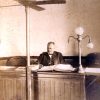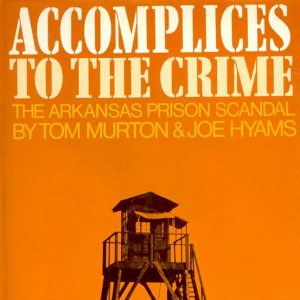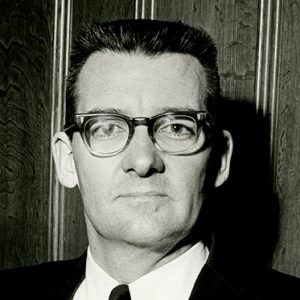calsfoundation@cals.org
Thomas Orhelius Murton (1928–1990)
Tom Murton is best known for his attempts to reform the Arkansas prison system during the governorship of Winthrop Rockefeller. Intelligent and conscientious with a dry sense of humor, Murton could also prove abrasive and uncompromising with others, especially his superiors. His uncovering of three skeletons at Cummins prison farm in early 1968 gained national attention, and his handling of the matter drew the ire of the Rockefeller administration. Murton wrote a bestselling book about his time in Arkansas, Accomplices to the Crime (1969), on which the 1980 movie starring Robert Redford was loosely based.
Thomas Orhelius Murton was born in Los Angeles, California, on March 15, 1928, the son of Oregon native Edmund T. Murton and Oklahoma native Bessie Glass Stevens Murton. Murton obtained a bachelor’s degree in animal husbandry from Oklahoma A&M (now Oklahoma State University) in 1950. After his parents’ divorce, Murton moved with his father to Alaska, where he worked for a time as a deputy U.S. marshal. After a stint in the military, during which he attained the rank of lieutenant, he worked as an army supplier. In 1964, taking advantage of the GI Bill, Murton enrolled at the University of California, Berkley, where he received a master’s degree (1966) and doctorate (1968) in criminology. His work focused on the history of the Alaska prison system. Murton also worked for Alaska’s fledgling prison system (Alaska had achieved statehood only in 1959). Officials in Alaska eventually fired Murton for giving controversial testimony concerning prison conditions there. It would not be the last time he would run afoul of his superiors.
When Rockefeller appointed him the head of Tucker State Prison Farm in Jefferson County in 1967, Murton was teaching penology at Southern Illinois University in Carbondale. Murton replaced former superintendent, Jim Bruton, who was removed in September 1966 after a fourteen-year tenure. Bruton had a reputation for brutality, including accusations that he personally tortured prisoners with the infamous “Tucker Telephone.” Murton immediately put an end to the use of the strap and other forms of corporal punishment.
Murton was shocked by Arkansas prisons—not only by their violence, but also by the use of barracks rather than cells to house prisoners as well as the trusty system, in which armed inmates (rather than regular guards) oversaw daily operations and maintained discipline. Murton saw the entire prison system as badly managed and corrupt. At Tucker, he modernized the parole system, which had traditionally been subject to the whims of trusties and wardens. Murton also improved the men’s diet, providing them with more meat, eggs, milk, and green vegetables. He also improved sanitation.
Typically clad in a work shirt and jeans rather than a suit, Murton believed in communicating honestly with the trusties, who sometimes responded better to straight-forward appeals than to threats. In one instance of what Murton called “Arkie-ology,” he persuaded an inmate to turn in his shotgun not through threats but by simply asking him.
Despite the progress he made, Murton understood the challenges he faced. When asked by a reporter what he thought of Tucker, he said, “Arkansas has probably the worst prison system…in America.” Murton was pragmatic rather than idealistic. He was skeptical of liberal theories about incarceration and rehabilitation, and he believed prisoners—rather than bureaucrats or administrators—should play a central role in democratizing the prisons. To buttress his claims, in August 1967, Murton issued a speedily written report on the state prison system that ran more than 100 pages. That same month, Murton announced he would be teaching a class in criminology at what is now the University of Arkansas at Little Rock (UA Little Rock).
Murton was largely successful in his efforts to bring Tucker into the twentieth century. And yet, while unquestionably energetic and principled, Murton was tone deaf to the political aspects and implications of his work. He was sharply critical of Sidney Koegles, a state purchasing manager and Rockefeller appointee, whom Murton claimed was too slow in making deliveries to Tucker. Murton also publicly accused O. E. Bishop, who ran Cummins prison, of interfering with and undermining his management of Tucker.
Nevertheless, given his success at Tucker, and following the resignation of Bishop on December 31, 1967, Murton was made temporary head of the Arkansas prison system, while the Prison Board searched for a permanent replacement. Murton moved to Cummins—near Grady (Lincoln County)—and was officially appointed to the position on January 15, 1968. Cummins, much larger than Tucker both in size and in its prison population, housed all of Arkansas’s adult prisoners (most of the inmates at Tucker were under the age of twenty), including female convicts. Cummins, furthermore, had an even worse reputation for violence, backwardness, and brutality.
Murton approached his new duties at Cummins with his customary zeal, implementing changes large and small. He allowed inmates greater freedom of movement and permitted them to paint their own cells. He also obtained funds to sponsor a music program. Murton also bettered the kitchen facilities and prisoner diet. He worked to eliminate overcrowding and attempted to minimize inmate-on-inmate sexual activity. Murton also made it a priority to bring attention and services to Cummins’s female inmates, some of whom were incarcerated for non-violent—indeed, what would today be considered non-criminal—offenses, such as alcoholism.
Murton’s work at Cummins, however, proved short-lived. On January 29, 1968, with the help of Reuben Johnson—an inmate who claimed to know the area—Murton, with national media on hand, uncovered three skeletons on the grounds near the prison facilities. Murton was convinced the corpses were those of murdered convicts and believed as many as 200 others—who had been declared “missing” in prison records—were buried on the grounds. Murton had searched for bodies the previous year at Tucker but found nothing. In the wake of his grisly findings at Cummins, he demanded an investigation.
Murton’s discovery, and the storm of national attention his actions brought on Arkansas, quickly brought him into conflict with the governor. The Rockefeller administration eventually sponsored a report, based in part on forensic evidence, rejecting Murton’s allegations that the exhumed skeletons were those of murdered men. Rather, the government’s official stance was that the bodies came from a paupers’ cemetery located near the prison. Murton, not surprisingly, was highly critical of the official report, which he believed was full of omissions and obfuscations. He was also highly dubious of the report’s claim that skull fractures on one skeleton had come from a cave-in of the grave. Nor could Murton account for why a pauper’s grave would contain a decapitated skeleton. Rockefeller himself called the report a “mishmash.” Later, in 1972, physical anthropologist Dr. Clyde Snow studied skeletons unearthed near Cummins that were given to him by the Arkansas medical examiner. Snow’s findings contradicted Reuben Johnson’s testimony. At the time, Snow did not side with either Murton or his critics, but the unmarked graves Murton had discovered were eventually considered to be part of a prison graveyard containing the bodies of prisoners no one had claimed.
Rockefeller fired Murton in early March 1968, as he had clearly become an outspoken political liability for Rockefeller, who complained of Murton’s “callous disregard for the problems of his equals and his superiors,” which led to a “totally untenable situation.”
By February 1970, Murton had moved with his wife, Margaret, and his four children to Alaska and was living on food stamps. Murton would continue to write extensively on prisons in America, but he would never work again at a penitentiary. Murton’s Accomplices to the Crime, published in 1969—in which he was frank about the abuses he observed at Arkansas’s prisons—sold well, but it took him some time to find work.
Murton was not alone in his contention that Arkansas’s prison system was woefully substandard. In 1970, in the second of two decisions in the landmark Holt v. Sarver case, a federal judge ruled the Arkansas prison system unconstitutional. Rockefeller, whom Murton lambasted in Accomplices to the Crime as hard-drinking, vacillating, and not truly committed to reform, failed to win a third term for governor that same year.
Throughout the 1970s, Murton remained active as an author and prison expert. He taught at the University of Minnesota from 1971 to 1979. His personal life suffered, however, during this time. By the time the film Brubaker premiered in 1980, Murton was living alone in Oklahoma (having divorced his wife), where he raised livestock; he seldom saw his four children. Murton made no money from the film loosely based on his book, though he worked as a consultant to the film and praised its historical accuracy. Brubaker, which was shot in Ohio, was profitable and well received, garnering an Academy Award nomination for Best Original Screenplay.
Murton continued to write and teach in Oklahoma, publishing The Dilemma of Prison Reform in 1982 and Crime and Punishment in Arkansas: Adventures in Wonderland in 1985. He died of cancer on October 10, 1990, in Oklahoma City at the Veterans Affairs Medical Center; he is buried in Bayard Cemetery in Deer Creek, Oklahoma.
For additional information:
“Bones from Cummins Don’t Support Charges, Anthropologist Finds.” Arkansas Gazette, April 14, 1972, p. 7A.
Fowler, Glenn. “Thomas Murton, 62, a Penologist Who Advocated Reforms, Is Dead.” New York Times, October 19, 1990, p. 28A. Online at http://www.nytimes.com/1990/10/19/obituaries/thomas-murton-62-a-penologist-who-advocated-reforms-is-dead.html (accessed November 26, 2025).
Hall, Sarah Moore. “Redford Plays Him Like a Hero, But the Real ‘Brubaker’ Can’t Get a Prison Job.” People Magazine (July 21, 1980): 103–4.
Murton, Tom. Crime and Punishment in Arkansas: Adventures in Wonderland. Stillwater, OK: Murton Foundation for Criminal Justice, 1985.
———. The Dilemma of Prison Reform. New York: Holt, Rinehart and Winston, 1982.
Murton, Tom, and Joe Hyams. Accomplices to the Crime: The Arkansas Prison Scandal. New York: Grove Press, 1969.
Norman, Geoffrey. “Interview with Tom Murton.”Playboy (February 1971): 59–78.
Urwin, Cathy K. Agenda for Reform: Winthrop Rockefeller as Governor of Arkansas, 1967–1971. Fayetteville: University of Arkansas Press, 1991.
Winthrop Rockefeller Collection. Center for Arkansas History and Culture. University of Arkansas at Little Rock, Little Rock, Arkansas.
Woodward, Colin. “The Arkansas Prison Scandal.” Arkansas Times, March 22, 2018, pp. 16–19. Online at https://www.arktimes.com/arkansas/the-arkansas-prison-scandal/Content?oid=15957051 (accessed November 26, 2025).
Colin E. Woodward
Center for Arkansas History and Culture









Although I can’t say the author got it 100% correct, it’s fairly close to my recollection, as I’m Tom Murton’s son. It was an exciting two years in Tucker and Cummins for a 5th grader. I agree about the “tone deaf” comment; however, corruption extended outward from Tucker to the surrounding community and ultimately to the legislature. The Arkansans of 1965 owned that piece.
The bodies are still buried there, and the Arkansans of today own that piece. In the miasma of 1965 Arkansas politics, even a politically savvy warden would have ultimately had to either kick principle to the curb or get fired, in this particular case.
In 2000, my sergeant major stopped by Tucker Prison on his way home to Birmingham, AL. Folks there still remembered Tom Murton.